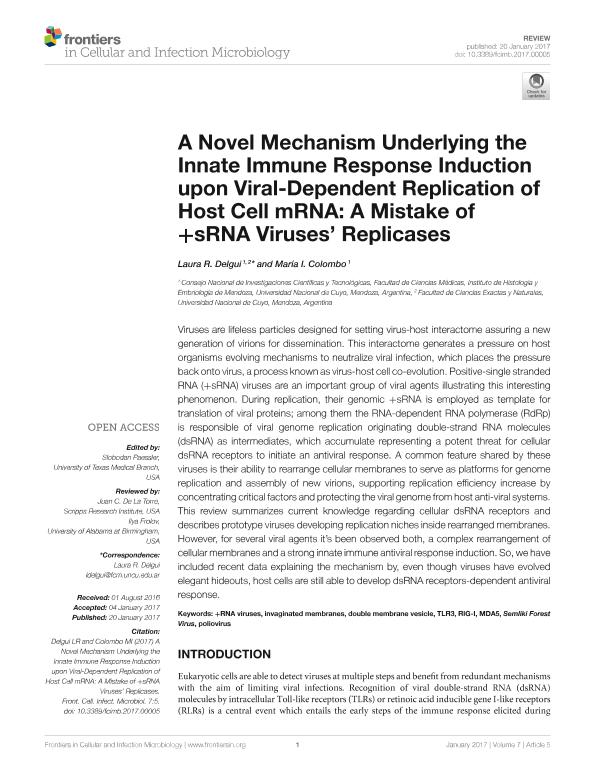Mostrar el registro sencillo del ítem
dc.contributor.author
Delgui, Laura Ruth

dc.contributor.author
Colombo, Maria Isabel

dc.date.available
2018-06-19T19:05:40Z
dc.date.issued
2017-01
dc.identifier.citation
Delgui, Laura Ruth; Colombo, Maria Isabel; A novel mechanism underlying the innate immune response induction upon viral-dependent replication of host cell mRNA: A mistake of +sRNA viruses' replicases; Frontiers Research Foundation; Frontiers in Cellular and Infection Microbiology; 7; JAN; 1-2017; 1-10
dc.identifier.issn
2235-2988
dc.identifier.uri
http://hdl.handle.net/11336/49391
dc.description.abstract
Viruses are lifeless particles designed for setting virus-host interactome assuring a new generation of virions for dissemination. This interactome generates a pressure on host organisms evolving mechanisms to neutralize viral infection, which places the pressure back onto virus, a process known as virus-host cell co-evolution. Positive-single stranded RNA (+sRNA) viruses are an important group of viral agents illustrating this interesting phenomenon. During replication, their genomic +sRNA is employed as template for translation of viral proteins; among them the RNA-dependent RNA polymerase (RdRp) is responsible of viral genome replication originating double-strand RNA molecules (dsRNA) as intermediates, which accumulate representing a potent threat for cellular dsRNA receptors to initiate an antiviral response. A common feature shared by these viruses is their ability to rearrange cellular membranes to serve as platforms for genome replication and assembly of new virions, supporting replication efficiency increase by concentrating critical factors and protecting the viral genome from host anti-viral systems. This review summarizes current knowledge regarding cellular dsRNA receptors and describes prototype viruses developing replication niches inside rearranged membranes. However, for several viral agents it's been observed both, a complex rearrangement of cellular membranes and a strong innate immune antiviral response induction. So, we have included recent data explaining the mechanism by, even though viruses have evolved elegant hideouts, host cells are still able to develop dsRNA receptors-dependent antiviral response.
dc.format
application/pdf
dc.language.iso
eng
dc.publisher
Frontiers Research Foundation

dc.rights
info:eu-repo/semantics/openAccess
dc.rights.uri
https://creativecommons.org/licenses/by-nc-sa/2.5/ar/
dc.subject
+Rna Viruses
dc.subject
Double Membrane Vesicle
dc.subject
Invaginated Membranes
dc.subject
Mda5
dc.subject
Poliovirus
dc.subject
Rig-I
dc.subject
Semliki Forest Virus
dc.subject
Tlr3
dc.subject.classification
Otras Ciencias Biológicas

dc.subject.classification
Ciencias Biológicas

dc.subject.classification
CIENCIAS NATURALES Y EXACTAS

dc.title
A novel mechanism underlying the innate immune response induction upon viral-dependent replication of host cell mRNA: A mistake of +sRNA viruses' replicases
dc.type
info:eu-repo/semantics/article
dc.type
info:ar-repo/semantics/artículo
dc.type
info:eu-repo/semantics/publishedVersion
dc.date.updated
2018-06-13T16:54:05Z
dc.journal.volume
7
dc.journal.number
JAN
dc.journal.pagination
1-10
dc.journal.pais
Suiza

dc.journal.ciudad
Lausanne
dc.description.fil
Fil: Delgui, Laura Ruth. Consejo Nacional de Investigaciones Científicas y Técnicas. Centro Científico Tecnológico Conicet - Mendoza. Instituto de Histología y Embriología de Mendoza Dr. Mario H. Burgos. Universidad Nacional de Cuyo. Facultad de Cienicas Médicas. Instituto de Histología y Embriología de Mendoza Dr. Mario H. Burgos; Argentina
dc.description.fil
Fil: Colombo, Maria Isabel. Consejo Nacional de Investigaciones Científicas y Técnicas. Centro Científico Tecnológico Conicet - Mendoza. Instituto de Histología y Embriología de Mendoza Dr. Mario H. Burgos. Universidad Nacional de Cuyo. Facultad de Cienicas Médicas. Instituto de Histología y Embriología de Mendoza Dr. Mario H. Burgos; Argentina
dc.journal.title
Frontiers in Cellular and Infection Microbiology
dc.relation.alternativeid
info:eu-repo/semantics/altIdentifier/doi/http://dx.doi.org/10.3389/fcimb.2017.00005
dc.relation.alternativeid
info:eu-repo/semantics/altIdentifier/url/https://www.frontiersin.org/articles/10.3389/fcimb.2017.00005/full
Archivos asociados
